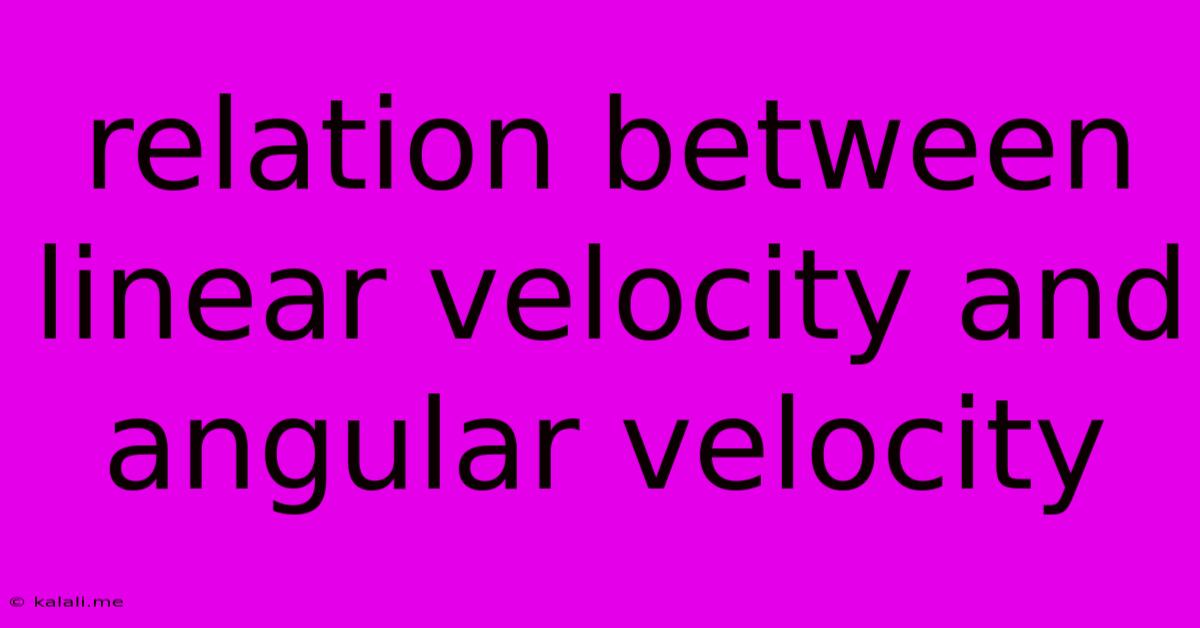Relation Between Linear Velocity And Angular Velocity
Kalali
Jun 16, 2025 · 3 min read

Table of Contents
The Intimate Dance of Linear and Angular Velocity: Understanding Their Relationship
Understanding the relationship between linear velocity and angular velocity is crucial in many fields, from physics and engineering to sports and even everyday life. This article will delve into the connection between these two vital concepts, explaining their definitions, the formula that links them, and providing real-world examples to solidify your understanding. Think of it as your comprehensive guide to unraveling the dynamics of rotational motion.
Linear velocity, simply put, measures how quickly an object changes its position along a straight line. It's typically expressed in meters per second (m/s) or kilometers per hour (km/h). Angular velocity, on the other hand, describes how fast an object rotates around a central point or axis. This is usually measured in radians per second (rad/s) or revolutions per minute (rpm). While seemingly different, these two velocities are intrinsically linked, particularly in rotational motion.
Defining the Players: Linear and Angular Velocity
-
Linear Velocity (v): This refers to the rate of change of an object's position along a straight path. It's a vector quantity, meaning it has both magnitude (speed) and direction. Imagine a car driving down a straight road – its linear velocity indicates how fast it's moving and in which direction.
-
Angular Velocity (ω): This describes the rate of change of an object's angular displacement. It's also a vector quantity, with its direction defined by the right-hand rule (pointing along the axis of rotation). Think of a spinning top – its angular velocity indicates how fast it's spinning and the orientation of its axis of rotation.
The Unifying Equation: Connecting Linear and Angular Velocity
The relationship between linear and angular velocity is elegantly captured in a single equation:
v = ωr
Where:
- v represents linear velocity
- ω represents angular velocity
- r represents the radius of the circular path or the distance from the axis of rotation.
This equation highlights that linear velocity is directly proportional to both angular velocity and the radius. A larger radius or a faster angular velocity will result in a higher linear velocity.
Real-World Applications: Seeing the Connection in Action
This relationship manifests in countless real-world scenarios:
-
A spinning merry-go-round: Children sitting closer to the center experience a lower linear velocity than those sitting near the edge, even though they all have the same angular velocity.
-
A rotating wheel: Points on the outer edge of the wheel have a greater linear velocity compared to points closer to the axle, despite sharing the same angular velocity.
-
A planet orbiting a star: The planet's orbital speed (linear velocity) is determined by its distance from the star (radius) and its angular velocity around the star.
-
Gear systems in machinery: The relationship between the linear and angular velocities of different gears dictates the speed and torque ratios in a machine.
Beyond the Basics: Exploring More Complex Scenarios
While the equation v = ωr is fundamental, understanding its application requires considering the context. In non-uniform circular motion, where angular velocity changes over time, the relationship becomes more nuanced, often involving calculus to determine instantaneous velocities.
Conclusion: Mastering the Interplay of Velocities
Understanding the relationship between linear and angular velocity is key to comprehending rotational motion. By grasping the fundamental equation and its implications, you can analyze and predict the motion of various rotating objects, from simple everyday examples to complex mechanical systems. The ability to connect these two concepts is invaluable in many scientific and engineering fields, proving the intimate dance between linear and angular velocity is essential to our understanding of the physical world.
Latest Posts
Latest Posts
-
Which Stage Of Mitosis Is The Longest
Jun 16, 2025
-
Which Of The Following Is True About Viruses
Jun 16, 2025
-
What Is The Difference Between Gmail And Email
Jun 16, 2025
-
What Is The Lcm Of 4 8 And 12
Jun 16, 2025
-
What Is The Colour Of Lymph
Jun 16, 2025
Related Post
Thank you for visiting our website which covers about Relation Between Linear Velocity And Angular Velocity . We hope the information provided has been useful to you. Feel free to contact us if you have any questions or need further assistance. See you next time and don't miss to bookmark.